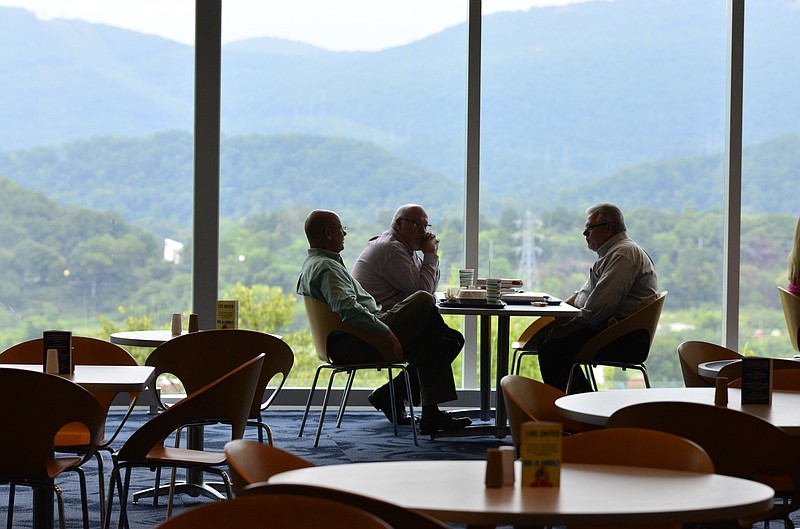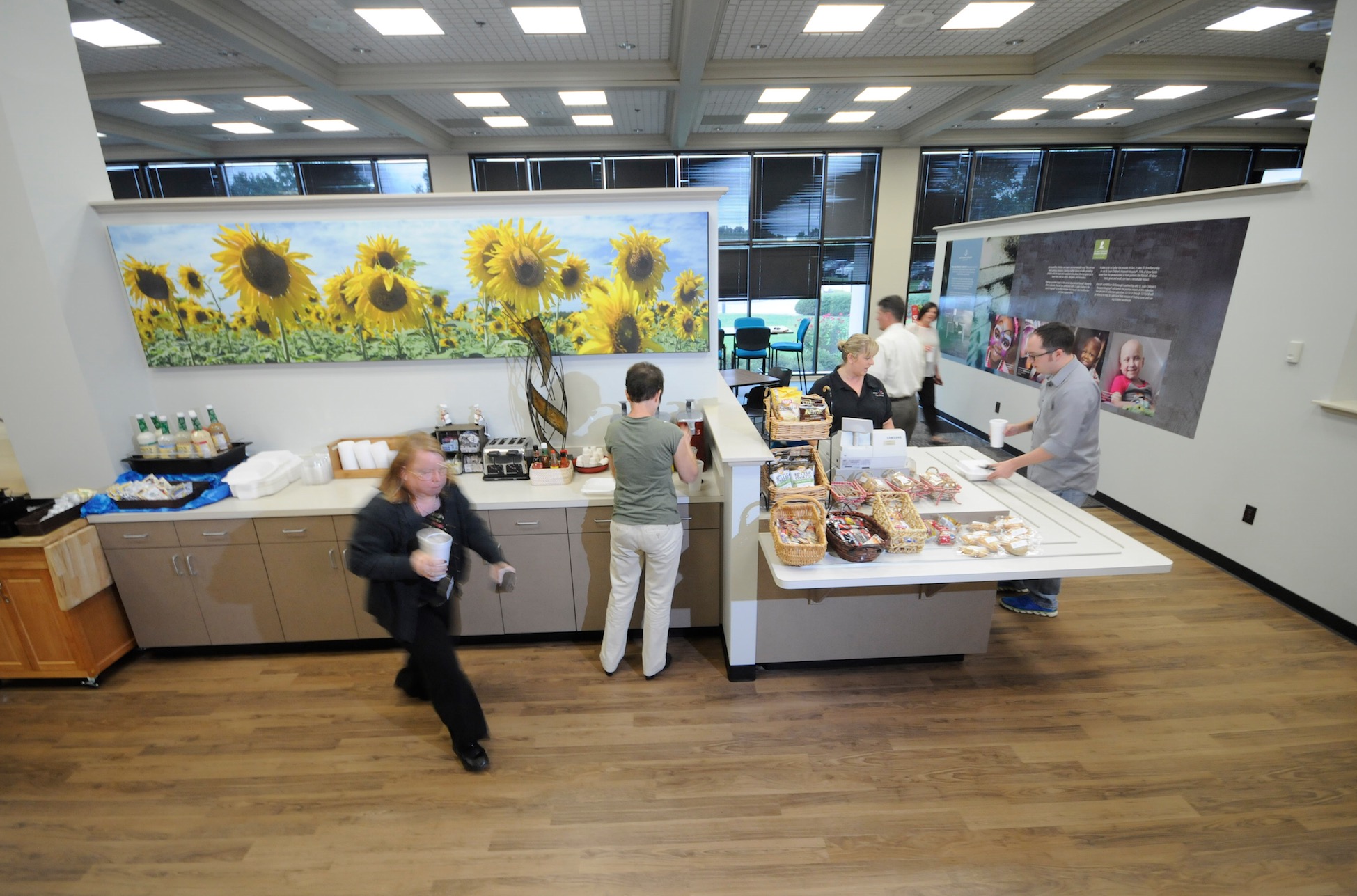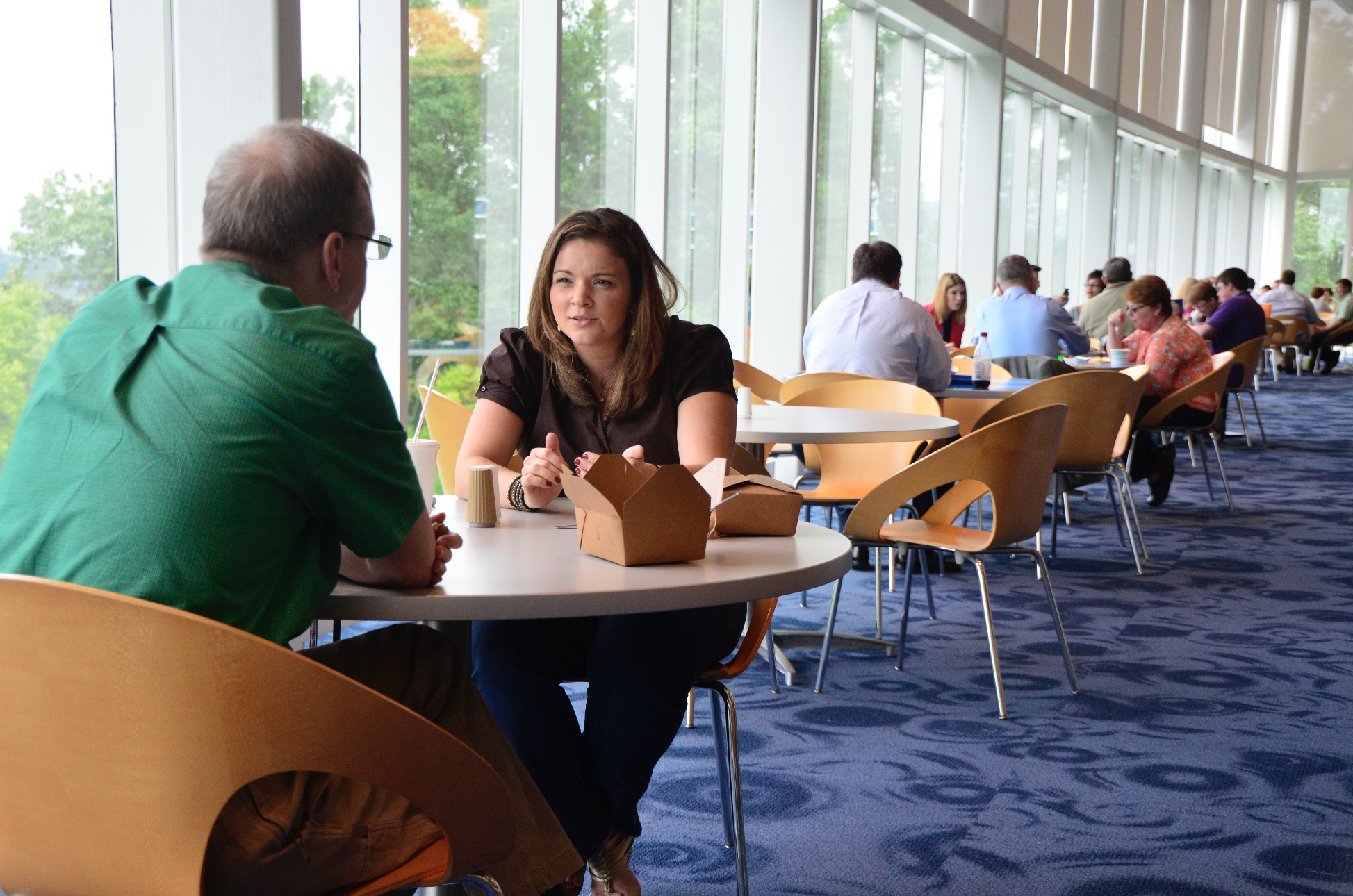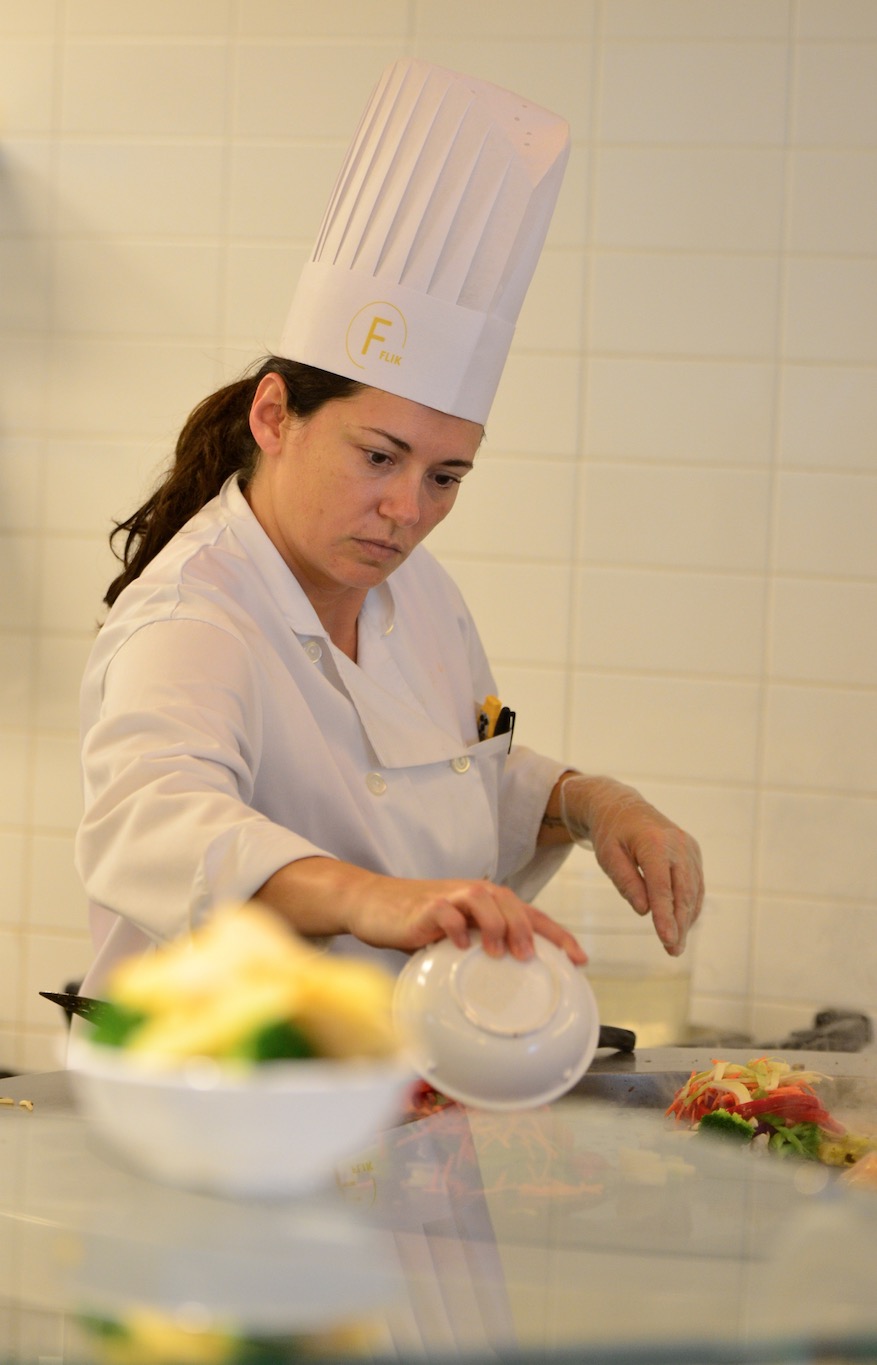You best not call a corporate cafeteria a "corporate cafeteria," even if that is what it is.
These days, companies prefer to call them "cafes." So do their employees, who often have a hand in naming them.
There are other trends: Most companies aim to feed their employees healthy food, though "healthy" varies in definition, and making it too healthy can prompt revolt. Televisions are ubiquitous in workplaces eateries. Light is important, mostly the natural kind and sometimes abundant thanks to outdoor seating.
Blue Cross Blue Shield of Tennessee's Hill Top Cafe sits, fittingly, on a hilltop and has a glass wall as broad and tall as a two-story house, with sweeping views of the Tennessee River, Lookout Mountain and Signal Mountain.
Volkswagen Chattanooga's Das Cafe includes a wooden deck with outdoor chairs and tables, under umbrellas in a seascape of colors.
Shaw Industries in Dalton, Ga., took a space with an outdated look and threw in bright hues: images of strawberries and sunflowers, carpet tiles in wake-you-up green, and seats padded in bright blue.
"It has this almost-like-Starbucks feel," says Jeff Swanson, Shaw's construction and planning manager. Which is to say, the atmosphere aims to mix high-tech access with lounge-like feel.
The carpet manufacturer added multiple seating options. There are high-top tables for two, four or six people, as well as low tables and club chairs. There is open access to the Internet.
"We have plugs where you can charge your cell phone or personal device while you're having coffee," Swanson says.
Cafe 72 reopened as a renovated version of itself last August. With that, Shaw wanted to offer healthier food (there are more vegetables now) and food with more flair (cooked sushi is making its debut). As important, it wanted an atmospherically inviting dining space, a place that allows associates to disconnect from their work. Plus, a good place to eat on-site is critical because many of Shaw's employees are customer services associates with tight schedules.
"They spend a lot of time on the phone," says Curtis W. Callaway, a Shaw spokesman. "They don't always have time to leave. Unless they bring lunch, they don't have many options. For them to come and sit in a bright and contemporary environment that offers them the ability to, maybe, get on the Internet, it's a way for them to kind of catch their breath."
Cafe 72 has a salad bar and a yogurt bar and fruit bar that's open for breakfast. Five Star Food Service, a Chattanooga company, offers its menu to about 800 employees at Shaw's main campus in Dalton.
A vending area offers food when the cafe is closed. It's got standard fare: candy bars and soda. But the swipe of a credit or debit card also gets employees juice, fruit, sandwiches and cereal.
"There are times when I walk over there to get an apple," Callaway says. "It allows people, no matter what time, to get something to eat or drink."
Prior to renovations the company saw about a 25 percent usage rate of Cafe 72. Since reopening, traffic has "definitely increased," Callaway says.
Volkswagen Chattanooga reports a far higher usage rate: about 70 percent of employees use any of its three cafes.
"I have never not been able to go and buy something; you just may not be able to get everything" all the time, spokesman Scott Wilson says.
Southern Foodservice Management, based in Birmingham, Alabama, serves breakfast and lunch. Lunch features eight stations.
Tasty and affordable on-site food is critical for VW Chattanooga, which employs 1,400 production workers. They have just 45 minutes for lunch, along with two 15-minute breaks.
"There is no way a production worker could leave and get lunch," Wilson says. The plant also has about 1,000 salaried workers, many of whom eat on-site.
To help workers, VW subsidizes the cost of meals. The Chattanooga location has had only one price increase in five years. It was across the board and so small - a few percentage points - it shouldn't have pinched employees' pocketbooks, Wilson says.
These days, for $4.99 employees can get a full meal at the "Smart Cuisine" station. That meal includes a main item, two sides, bottled water, and fresh fruit cup or yogurt. A recent day offered roasted tilapia with a salsa topping and sides of green beans, rice or a squash and zucchini medley.
If workers don't see something they want to eat they can say so, and VW's general services specialist, Andy Giffen, will do what he can to get it.
"I'll ask, 'Is it a really expensive item or something we just don't have?' " Giffen says. "Scott asked for green olives, and two days later they were there."
Once a year the company has a "diversity week" and features food from different countries - along with factoids on the countries: chorizo shrimp and rice for Portugal, moo goo gai pan for China. Currywurst, a German favorite, gets the spotlight once every week, though. The spices for that come from the mother country.
"It's like the best hot dog you ever had, but you don't have a bun with it," Wilson says. "You just eat it on a plate with fries you can sprinkle with curry powder and can have with curry ketchup."
Healthy choices
When Blue Cross Blue Shield's 3,000 employees chart their gustatory game plan in the company's cafe, they could just as well be eating at a swanky eatery that's committed to sustainability. Then they can play ping-pong.
Hill Top Cafe soothes the senses with its clean white lines, light wooden accents and breathtaking backdrop of sky and mountain. As far as food goes, it should come as no surprise that a health-care company would oblige itself to have a healthful menu and endorse healthy practices.
Blue Cross has an on-site dietitian. Allison Knott's office is located just off the kitchen, so she can work directly with the chef and culinary team. She plays an integral role in menu writing, recipe testing and recipe development. During lunch hours, she can be found in the cafe, where she is easily accessible to all guests, says Blue Cross Spokesman John Hawbaker.
Flik International started serving artful and tasty fare at the health insurer in January 2014. Blue Cross worked up a contract that calls for the Rye, New York, company to keep per-item prices under the market average within a two-mile radius. The companies declined to share how much below the market average.
Flik, which is part of Compass Group North America, markets itself as having a "fresh perspective."
Flik lists its healthiest menu choices at eye level. The company reports using eggs from cage-free chickens, milk free of artificial growth hormones and beef raised without antibiotics, steroids or added hormones. It buys local whenever possible and reports using several Chattanooga-area businesses on a regular basis, including Bluff View Bakery and Everett Heritage Farm. Taziki's Cafe, Milk and Honey Gelato and Famous Naters have made guest appearances, Flik says. Take-out containers are compostable.
Vegan or vegetarian options are available at every food station, every day - and there are a good half dozen stations. During a recent afternoon, the Mongolian grill offered tofu, and a homemade quinoa chickpea burger ($3.36) was at the grill. Meat eaters had dozens of choices: beer, bacon and cheddar soup and a lemon pepper chicken wrap ($5) to name two. Chicken tenders ($5) are a favorite. Food is served out of elegant white dishes, not industrial cafeteria pans.
Things weren't always so appetizing.
For about four years, Blue Cross was so strict about serving only healthy food, its employees increasingly avoided eating in the cafeteria. Entrees followed strict calorie guidelines, most food had reduced salt and fat, and fried food was absent altogether for a time. At one point, tired of the stringent in-house choices, workers bought and sold candy bars and illicit snacks out of their desks.
Cafeteria usage was about 22 percent.
"Employees did not like being mandated to what they could and could not eat," says Tyler Sanderson, director of Blue Cross's Total Rewards program. "The concept was flawed from the beginning."
That included the cafeteria's name: "the nutrition center."
"I don't know that that sounds like a place where you truly want to eat lunch," Sanderson says, wrinkling his nose.
The recipe for a better name, the company decided, was to ask employees for suggestions, and then have them vote on it. Hill Top Cafe came to be. Something similar went down in choosing Flik. A company-wide selection committee of 25 people unanimously voted for the vendor. Five vendors had bid for the work.
Now Hill Top has about a 40 percent usage rate, not bad considering restaurants are five or 10 minutes away - and the company provides shuttles downtown every 15 minutes.
"We didn't want people to come here because it was their only option," Sanderson says.
Employees can still pay attention to calories if they choose. Some are posted, and all counts can be pulled up on a touch pad. Employees can use an app called myfitnesspal to track their own consumption.
Sanderson does.
This article first appeared in Edge magazine. Read the monthly business magazine at http://www.meetsforbusiness.com/flipbookArchive.php



